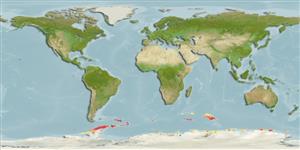Classification / Names
Common names from other countries
Main reference
Size / Weight / Age
Max length : 24.0 cm TL male/unsexed; (Ref. 5179)
Length at first maturity
Lm 22.5 range ? - ? cm
Environment
Marine; benthopelagic; depth range 30 - 750 m (Ref. 51730)
Climate / Range
Polar; -1°C - 2°C (Ref. 51730), preferred -1°C (Ref. 107945); 45°S - 70°S
Distribution
Southern Ocean: Balleny Islands, Peter I Island, Palmer Archipelago, Graham Land, South Shetlands, South Orkneys, South Sandwich, South Georgia, Shag Rocks, Bouvet, and sub-Antarctic islands and seamounts of the Indian Ocean Sector (except Kerguelen, Heard, McDonald and Macquarie islands and Kara Dag seamount).
Countries | FAO areas | Ecosystems | Occurrences | Introductions
Short description
Dorsal
spines
(total): 5 - 6;
Dorsal
soft rays
(total): 37-39;
Anal
soft rays: 37 - 38. Irregular oblique dark cross-bars on body. Distal part of spinous dorsal with black blotch, soft dorsal with oblique dark stripes. Anal plain or similarly marked. Breast to middle depth of pectoral fins a notable silvery-white (Ref. 11892).
IUCN Red List Status (Ref. 115185)
Threat to humans
Harmless
Human uses
More information
ReferencesAquacultureAquaculture profileStrainsGeneticsAllele frequenciesHeritabilityDiseasesProcessingMass conversion
Tools
Special reports
Download XML
Internet sources
Estimates of some properties based on models
Phylogenetic diversity index
PD50 = 0.6250 many relatives (e.g. carps) 0.5 - 2.0 few relatives (e.g. lungfishes)
Trophic Level
3.3 ±0.3 se; Based on diet studies.
Resilience
Medium, minimum population doubling time 1.4 - 4.4 years (K=0.27; Fec = 2,046)
Vulnerability
Low to moderate vulnerability (34 of 100)
Price category
